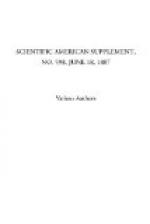[Illustration: FIG. 1.]
The sloped out corner affords the free space necessary for the rod of the opposite pole, and one and the same plate may be indifferently connected either to the + or the — at the right or the left. The plates are made of four different sizes: No. 1, 19 of which serve for an accumulator of 1 square meter; No. 2, 21, 25, or 29 of which serve for accumulators of 2, 3, and 4 square meters; No. 3, which with 21, 25, or 29 plates composes accumulators of 5, 6, and 7 square meters; and No. 4, which with 21, 23, 25, 27 or 29 plates forms accumulators of 8, 9, 10, 11, and 12 square meters.
As the plates are entirely submerged in the liquid their entire surface is active, and the entire surface being absolutely flat, it is sufficient to preserve their respective distance at any one point in order to have it everywhere alike. The weight of the plate depends on the intended duration of the plate and its capacity. As for the negative plate, its thickness is the most important factor of its capacity. The proportion has yet to be established for daily practice. The inventor uses in practice positive plates of 0.002 meter in thickness. On the other hand, the negative plates have a body of only 0.001 meter in thickness, their greater thickness being due only to the deposit of compressed lead. The rod which fixes the plate to each pole (Fig. 2) is formed of a special alloy of lead and antimony, not attacked by acid. This gives rigidity to the rod, and hinders it from binding when the accumulator is taken out of its case. The copper piece which surmounts it is fitted at its base with an iron cramp, which is fixed in the lead, and above which is a wide furrow with two grooved parts, which being immersed in the lead hinders the copper from slipping round under the action of the screw. The rod is square, and is cast in a single piece. Against one of its surfaces the ends of the connected plates press flatly up. A square form has been selected to give more surface for soldering. The soldering is autogenous (as in the lead chambers at vitriol works). The soldering, as well as the entire plates, is entirely immersed in the liquid, and to prevent any leakage an insulating varnish, perfectly proof against the acid and the current, is laid over the rod from the part soldered upward.




